
Vegetables in Sailor's Accounts Menu: 1 2 3 4 Next>>
Vegetables in Sailors Accounts During the Golden Age of Piracy, Page 2
Vegetables Found In Sailor's Accounts
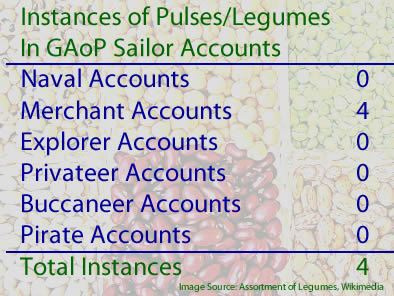
Legumes
(Fabaceae)
Called by Sailors: Legumen, Pulse
Appearance: 4 Times, in 2 Unique Ship Journeys from 2 Sailor Accounts.1
Locations Found in Sailor's Accounts: Quiriyat, Oman, Africa; Sri Lanka; Parangipettai, India; Cape of Good Hope, Africa
Of the three general categories of vegetables discussed in the period sailor accounts, pulses/legumes have the least amount of support, appearing in only two of them. This isn't to say that pulses themselves are rare in the sailors accounts; beans and peas have widespread support. Rather, it is more likely that most authors didn't refer to them by their generic names. In fact, three of the four uses of these terms are found in sailor Alexander Hamilton's book with other generic terms for items he found in the markets while sailing in the East Indies. This may have been because he didn't know what to call the legumes he found there or because he felt English readers wouldn't be very familiar with them. When Hamilton does talk about specific vegetables in his book, it's those that would be instantly familiar to English reader such as corn, French beans, potatoes and yams.
Before proceeding, it is worth discussing the words 'legume' and 'pulse', which have distinct meanings today. According to the Harvard School of Public Health, "A legume refers to any plant from the Fabaceae family that would include its leaves, stems, and pods. A pulse is the edible seed from a legume plant. Pulses include beans, lentils, and peas. For example, a pea pod is a legume, but the pea inside the pod is the pulse."2
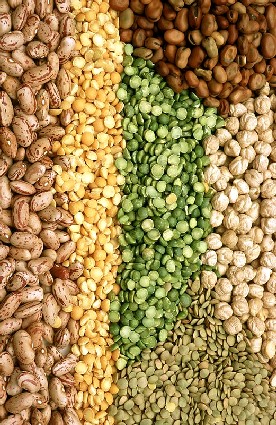
Photo: CSIRO Science Image - Pulses and Legumes
Edward Phillips' dictionary from the period defines legumes as "all manner of Pulse" and pulses as "a general Name for all those sorts of Grain that are contain'd in Cods, Husks, or Shells."3 John Worlidge says legumes are "that Species of Plants, which is commonly call'd Pulse, and are call'd Legumes from Lego in Latin, to gather, because they may be gathered by the Hand without cutting"4. While the essence of the modern meaning can be found in these definitions if you parse them very carefully, it is easy to see why contemporary sailors might would use pulse and legume interchangeably.
Semantics aside, what did people during the golden age of piracy consider pulses? Phillips' dictionary says pulses include "Pease, Beans, Vetches, Tares, &c."5 'Peas' and 'beans' cover every specific reference to legumes in the sailor's account other than lentils. Vetches (genus Vicia) include over 240 species of flowering legumes, most of which are no longer used as food. (The exception being broad beans.) Phillips defines tares as "a type of Vetches; a Plant"6. Elisha Coles' dictionary suggests that 'tares' are "(wild) vetches".7 Referencing the biblical parable of the wheat and the tares (Matthew 13:24–43), Samuel Johnson describes them as weeds8, most likely referring to darnel (Lolium temulentum). It looks very much like wheat, but the seeds are poisonous."
Herbalist John Gerard says there are many sorts of pulses, talking about most of those Phillips mentioned, adding 'ciches' or chickpeas.9 He devotes over 40 pages of his Herball to pulses with entries for different types of beans, 'peasons' (peas), ciches, lentils, vetches, sesamums (a genus which includes sesame seeds) and 'pease earth nuts' (peanuts), among others.
Fellow early seventeenth century Herbalist John Parkinson 'reduces' edible pulses to peas and beans, noting that

Image: John Haynes - Chelsea Physic Garden Plan View (1751)
some are tame and others wild. He says, "Of Beanes, besides the tame or usuall garden Beane, and the French or Kidney Beane, ...there is the Lupine or flat Beane... and the blacke Beane and others which must bee reserved for the Physicke Garden [medicinals]. And of the kindes of Pease some are fit ...for the Kitchen, the rest for the Physicke garden.10 So, in addition to dividing legumes by their cultivation, Parkinson defines them by their use as food or medicine. All foods were said to have some medicinal properties.
It is difficult to provide specifics about the period perceptions of the flavor, use and medicinal properties of such a broad category. Physician Hans Sloane explains that in Jamaica, he found "Pease, Beans, and Pulse of sorts different from those of Europe... They are eaten when green, as ours of Europe, and when dry, boil'd, afford[ing] the Negro very good and strong Provision."11 This is probably as good a description of how various legumes could be prepared as anything. Note that it suggests that as local food, they were consumed primarily by the slaves. Here again, vegetables are being dismissed as a basic food.
Sloane is not alone in this assessment. East India Priest John Ovington rather backhandedly praises pulses during a stop at Madeira as "a great part of the Diet of our Forefathers and Antediluvian Patriarchs, and very Congenial to the Nature of Man; so is this spare Food, with a
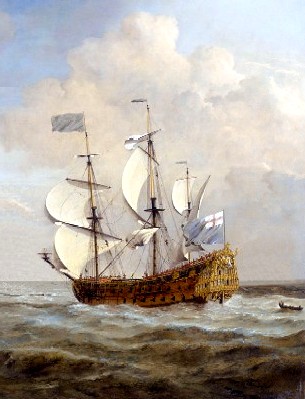
Artist: Willem van de Velde the Younger
First Rate HMS St. Andrew at Sea (c. 1673)
very moderate mixture of Flesh, the frequent Repast even of those here of better Note"12. Even pro-vegetable diet merchant Thomas Tryon dismisses beans and peas as "Mars's Grains, being drier and courser than" bread.13 (Tryon elsewhere notes that things associated with Mars are "savage and unclean"14.) He suggests that dried legumes are better than fresh, because they "afford a better and finer Nourishment, not so apt to generate Crudities in the Body when they are boyl'd in plenty of Water... But Green [fresh]-Pease and Beans are indu'd with a gross Phlegmatick Nature, and being frequently eaten generate many gross raw Humours in the Body"15.
Whatever the perception of legumes, they were the only type of vegetable regularly found at sea during this period, in large part due to the navy's use of them in the standard sea diet beginning well before the golden age of piracy.16 This was at least in part because they could be dried and preserved for long periods and were prepared by the preferred naval cooking method of boiling. When the peas ran out and not available because of a ship's location, they
substituted the local dried pulse. In the Mediterranean or the West Indies it was 'calavances', a type of haricot bean (Phaseolus vulgaris) also known as the French, canellini or navy bean; sometimes chick peas (Cicer arietinum) might have been substituted. In the East Indies the substitute was referred to as 'dholl', which equates to the modern spelling of dhal or dal; this could be anything from split chick peas to the larger forms of lentils (Lens escuknta), some of which are very much like the yellow pea. All these were issued weight for weight for pease.17
1 Alexander Hamilton, A New Account of the East Indies, 1746, p. 68, 280 & 353; John Ovington, A Voyage to Suratt in the Year 1689, 1696, p. 13; 2 “Legumes and Pulses”, Harvard School of Public Health Website, gathered 8/31/22; 3 Edward Phillips, “Legumen” & "Pulse", The new world of words, 6th ed, 1706, not paginated; 4 John Worlidge, Nathan Bailey, “Legumes”, Dictionarium Rusticum, Urbanicum & Botanicum, Vol. 2, 1726, not paginated; 5 Phillips, “Legumen”, The new world of words, not paginated; 6 Phillips, "Tare", The new world of words, not paginated; 7 Elisha Coles, “Tares”, An English Dictionary, 1717, not paginated; 8 Samuel Johnson, “Tare” A dictionary of the English language, 2nd part, 1756, not paginated; 9 John Gerard, The Herball or General Historie fof Plantes, 2nd ed, 1636, p. 1208; 10 John Parkinson, Paradisi in Sole Paradisus Terrestris-, 1904, p. 335; 11 Hans Sloane, A Voyage to the Islands Madera, Barbados, Nieves, St Christophers and Jamaica, Vol. 1, 1707, p. xix; 12 John Ovington, A Voyage to Suratt in the Year 1689, 1696, p. 13-4; 13 Thomas Tryon, The way to health & long life, 1697, p. 138; 14 Tryon, p. 66; 15 Tryon, p. 139; 16 J. D. Davies, Pepys's Navy, 2008, p. 152; 17 Janet MacDonald, Feeding Nelsons Navy, 2014, p. 34
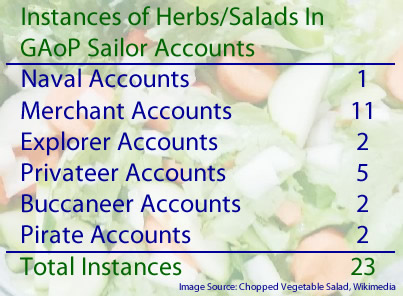
Salading
Called by Sailors: Garden-Fruit, Garden Trade, Green Trade, Greens, Herbage, Herbs, Salading, Salads, Saliting, Sallads
Appearance: 23 Times, in 14 Unique Ship Journeys from 13 Sailor Accounts.1
Locations Found in Sailor's Accounts: Marseilles, France; Almayate, Spain; Barbados; Salvador, Brazil; Coquimbo, Chile; Hilo, Peru; Borneo, Jakarta & Timor, Indonesia; Trengannu, Malaysia; Guam; São Tomé, Príncipe, and Annobón; Gabon, Africa; Cape Coast Castle, Africa; St. Helena; Cape of Good Hope, Africa;
In the general vegetables category, green vegetables had the greatest support from the period sailors writing during the golden age of piracy. Support is found in all six types of voyage accounts, as seen in the graphic above. The words 'herb' and 'salad' (along with a variety of terms including the adjective 'green') were used to refer to such vegetables.
Minister and logician Isaac Watts explained the various terms were based on what part of a plant was eaten and how it was consumed.
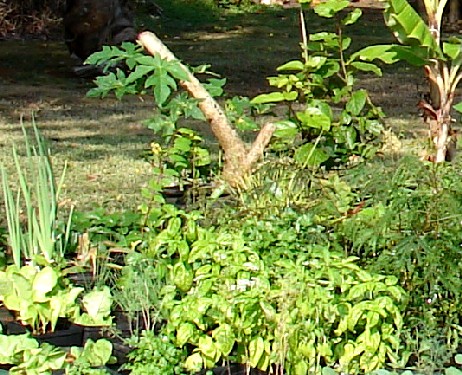
Photo: Forest and Kim Starr - A Garden Containing 'Green Trade'
"If the Leaves are of chief Use to us, then we call them Herbs; as Sage, Mint, Thyme: If the Leaves are eaten raw, they are termed Sallad; as Lettuce, Purslain: If boiled, they become Pot-herbs; as Spinage, Cole-worts; and some of those same Plants, which are Pot-herbs in one Family, are Sallad in another."2
However, encyclopedist Ephraim Chambers, who wrote during the same period, defines the words differently. He uses the more familiar definition of a salad as a mixture "of eatable Herbs ...seasoned with Salt, Oil, and Vinegar."3 (This definition is likely derived from John Evelyn's earlier book which defines salads as containing "certain Esculent [edible] Plants and Herbs, improv’d by Culture, Industry, and Art of the Gardner: Or, as others say, they are a Composition of Edule [edible] Plants and Roots of several kinds"4) Chambers defines an Herb as "a Name common to all Plants whose Stalks, or Stems, die away every Year, after their Seed is become ripe." He further notes that herbs can be subdivided into "Kitchin, or Sallet-Herbs, and Medicinal Herbs".6 In his Sallad entry, he indicates that pot-herbs are those which have been cooked or prepared.
Chambers provides a list of vegetables which calls 'sallet-herbs', which are "those which ordinarily make the
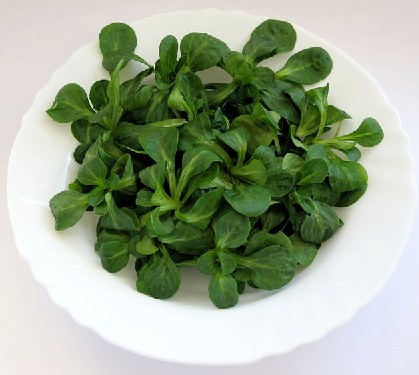
Photo: Wiki User Schwäbin - Corn Salad or Lamb's Lettuce (Valerianella locusta)
Basis of our English Sallets". He includes "Lettice, Sellery, Endive, Cresses, Radish, and Rape [Brassica napus], &c. Along with which, by way of Furniture, or Additionals, are used Purslane, Spinage, Sorrel, Taragon, Burnet, Corn-Sallet [lamb’s lettuce - Valerianella locusta], and Chervil"6. He later says that some people include other vegetables like cresses, mustard, dandelion, violets, cowslips, burrage blossoms, fennel and parsley.
Nathan Bailey's dictionary mentions several of the same vegetables, adding Rampion (Campanula rapunculus) and noting that people "generally eat Sellery by it self, also sweet Fennel."7 Herbalist John Parkinson mentions several additional green vegetables for salads including cabbage, coleworts, tansy (Tanacetum vulgare) and parsley.8 Note that all these descriptions come from authors describing salad herbs or greens found in England; when these sweeping terms are found in the sailors' accounts, it likely referred to whatever green leafy vegetables they found in the places their ships stopped.
Even with these definitions, there was some confusion over what sailors were referring to when they appear to have been talking about salad greens. In merchant Nathaniel Uring's landfall at Cape Coast Castle in Africa in May of 1710 he notes that they have "a very fine and large Garden… [containing] all sorts of Greens, as Cabbages and Lettices of several sorts, and other Esculents [edible plants]"9. This fits very nicely in what we would consider salad greens. Buccaneer-turned-explorer William Dampier said that when the Roebuck stopped for supplies at Salvador, Brazil in March of 1699,
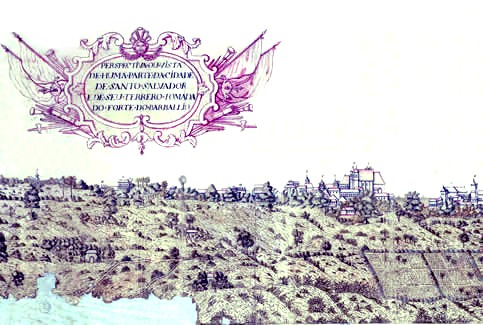
San Salvador, Brazil, Tomada da cidade de São Salvador (1700s)
they found of "Garden Herbs ...good store; as Cabbages, Turnips, Onions, Leeks, and abundance of other Salading, and for the Pot."10 Note that this curious definition of 'garden herbs' includes several root vegetables. In the book describing the latter half of this journey, Dampier mentions that on Timor Island, there were "plenty of all sorts of Sallads, Cabbages, Roots for the Kitchen"11. Here, salad greens are plainly differentiated from roots and cabbages. Still, based on these passages, it appears that Dampier considers garden herbs a broader category than salad greens. Sailor Francis Rogers makes an interesting distinction during the merchant Arabia's stop at St. Helena Island in 1703: "Here is great plenty of green trade, as oranges, lemons (the lemons are very large and fine), grapes, etc., and all manner of garden trade common with us"12. Here, 'green trade' referred to fruits while 'garden trade' referred to vegetables. However, it is unlikely that this distinction was universal given the imprecise terminology of the period.
Most of the other comments of interest concern the variety of salad greens found in various places. Sailor Edward Barlow says he found "all sorts of ‘saliting’ and roots" in Marseilles in 167513 and "very good herbs and ‘salleting'" at Barbados in 1678.14 (His separation of herbs and salad greens is notable.) When the buccaneer vessels May-Flower and Trinity ships stopped Coquimbo, Chile, Basil Ringrose said they could "refresh our selves, finding plenty of Hogs, Fowls, Mutton, and Sallads"15.
1 Edward Barlow, Barlow's Journal of his Life at Sea in King's Ships, East and West Indiamen & Other Merchantman From 1659 to 1703, p. 270 & 312; Edward Cooke, A Voyage to the South Sea and Round the World, Vol. 2, 1712, p. 60, 68 & 93; William Ambrosia Cowley, "Cowley's Voyage Round the Globe", A collection of original voyages, William Hacke, ed., 1993, p.16-18, 19; William Dampier, A New Voyage Round the World, Vol III, 1703, p. 72; Dampier, A Continuation of a New Voyage Round the World, Vol III, 1709, p. 56; Pirates in Their Own Words, Ed Fox, ed., 2014, p. 244-5; William Funnell, A Voyage Round the World, 1969, p. 294; Alexander Hamilton, A New Account of the East Indies, 1746, p. 439; Daniel Defoe (Capt. Charles Johnson), A General History of the Pyrates, Manuel Schonhorn, ed., 1999, p. 183 & 242; Basil Ringrose, The Adventures of Capt. Barth. Sharp, And Others, in the South Sea, 1684, p. 34 & 41; Francis Rogers, "The Diary of Francis Rogers", Three Sea Journals of Stuart Times, 1936, p. 191; Henry Teonge, The Diary of Henry Teonge, 1825, p. 268; Nathaniel Uring, The Voyages and Travels of Captain Nathaniel Uring, 1928, p. 106-7; 2 Isaac Watts, Logick, 1726, p. 89; 3 Ephraim Chambers, "Sallet", Cyclopaedia, 1728, Vol 2, p. 11 [Irregular pagination]; 4 John Evelyn, Acetaria, or a Discourse of Sallets, 1699, p. 1; 5 Chambers, "Herb", Cyclopaedia, 1728, Vol 1, p. 239; 6 Chambers, "Sallet", Cyclopaedia, Vol 2, p. 11 [Irregular pagination]; 7 Nathan Bailey, "Sallet-Dressing", Dictionarium Rusticum, Urbanicum & Botanicum, 1704, not paginated; 8 John Parkinson, Paradisi in Sole Paradisus Terrestris, 1904, p. 468-470; 9 Uring, p. 107; 10 Dampier, A New Voyage..., 1703, p. 72; 11 Dampier, A Continuation of a New Voyage ..., 1709, p. 56; 12 Rogers, p. 191; 13 Barlow, p. 270; 14 Barlow, p. 312; 15 Ringrose, p. 41
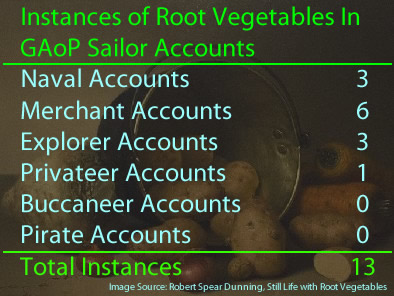
Roots
Called by Sailors: Garden-Fruit, Garden Trade, Green Trade, Greens, Herbage, Herbs, Salading, Salads, Saliting, Sallads
Appearance: 13 Times, in 9 Unique Ship Journeys from 6 Sailor Accounts.1
Locations Found in Sailor's Accounts: Algiers, Algeria; Sierra Leone, Africa; St. Helena; Cape of Good Hope, Africa; Quiriyat, Oman, Africa; Parangipettai, India; Sri Lanka; Bengkulu, Sumatra; Timor, Indonesia; Palau Sabuda, West Papua; Fulleborne, New Britain; Portugal
The generic category 'root vegetables' in the sailor's accounts from this period are always simply called 'roots'. Samuel Johnson defines 'root' (3rd definition) as, "A plant of which the root is esculent [edible]"2,
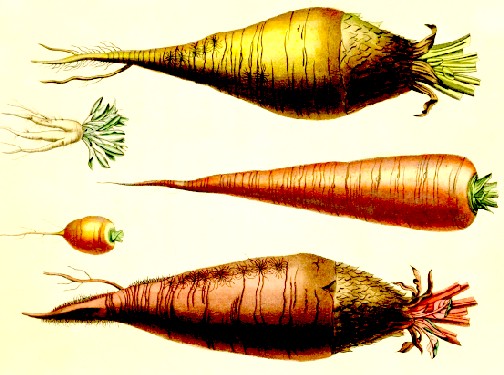
Racines Elementaires (Food Roots) From Top - Long Yellow Beet, Rampion, Common Carrot, Short
Early Carrot, Long Red Beet, From Le Règne végétal, By Pierre-Oscar Reveil, Frederic Gerard;
Augustin
Dupuis & Edouard Maubert (1871)
sourcing this meaning to minister and logician Isaac Watts book Logick. Watts explains, "those Plants whose Roots are eaten shall appropriate the Name of Roots to themselves; such are Carrots, Turnips, Radishes, &c"3. In discussing root vegetables, herbalist John Parkinson mentions red beets, rampions, horse radish, skirrets (Sium sisarum) and goat's beard (Tragopogon pratensis).4 John Evelyn gives a longer list of root vegetables in his book on salads, including Beets, Chervil, Dandelion, Earth-Nuts [Bunium bulbocastanum], Goats-beard, Onion, 'Persley', Radish, Horse-radish, Rampion, Skirrets and 'Ornithogalon' (Ornithogalum).5 So there are many vegetables which the term 'roots' covers according to contemporary authors.
They are found in a variety of sailor's accounts, indicating that root vegetables were a regular part of the sailor's diet, although this would have primarily been when they made landfall or within a few weeks of that based on the accounts of food available on long sea voyages. Root vegetables are even mentioned by the Victualling Board in a letter sent to the Secretary of the Admiralty in 1703 outlining food eaten while in port (aka. petty warrant victualling): "when in petty warrant victualling, the constitution [of the sailor's diet] is fresh meat, and bread in loaves. These, together with a continuance of paying short-allowance money, as at present practised (wherewith they will buy roots and other
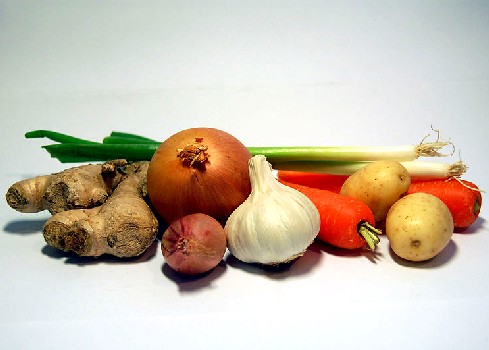
Photo: Alex Lomas - Common Root Vegetables Today
refreshments), leads us to think the same in its present usage a very good and wholesome state of victualling."6 (Sailors more likely used their petty warrant money to buy alcohol while in port, but that is a subject for another article.) Root vegetables can survive for several months without refrigeration provided they are kept in a cool place and kept damp, but no account from this period suggests they were included among foods carried to sea on long distance voyages.
In regard to preparation, roots were generally boiled. In his commentary on the East Indies, Charles Lockyer, author of An Account of the Trade in India, noted that in Canton, China they had "Roots for boiling. Carrots and Turneps are as common and cheap as in our Markets, and esteem'd the greatest Daintys by Europeans, who have lived in other Parts of India, where nothing of that kind is to be had."7 The root vegetables which Parkinson mentions preparing are boiled and pared, although he does state that some of them can be eaten cold. This could be taken to mean that they were eaten raw (like radishes), although that is not specifically stated. During his exploratory voyage to Australia, William Dampier said that at Fulleborne, New Britain he found "Ginger, Yamms, and other very good Roots for the Pot", indicating that they were to be boiled.8
1 John Atkins, A Voyage to Guinea and Brazil, 1735, p. 49; Edward Barlow, Barlow's Journal of his Life at Sea in King's Ships, East and West Indiamen & Other Merchantman From 1659 to 1703, p. 58 & 81; Edward Cooke, A Voyage to the South Sea and Round the World, Vol. 2, 1712, p. 93; William Dampier, "Part 1", A Supplement to the Voyage Round the World, 1700, p. 181 & 182; Dampier, A Continuation of a New Voyage Round the World, Vol III, 1709, p. 56, 98 & 143; Alexander Hamilton, A New Account of the East Indies, 1746, p. 68, 280 & 353; John Ovington, A Voyage to Suratt in the Year 1689, 1696, p. 13; 2 Samuel Johnson, “Root", A dictionary of the English language, 2nd part, 1756, not paginated; 3 Isaac Watts, Logick, 1726, p. 88; 4 John Parkinson, Paradisi in Sole Paradisus Terrestris, 1904, p. 468-470; 5 John Evelyn, Acetaria, or a Discourse of Sallets, 1699, p. 11, 18, 23, 24, 28, 47, 54, 56, 59, 60, 64 & 74; 6 R. D. Merriman, “10. Victualling Board to Secretary of the Admiralty, 23rd December 1703”, Queen Annes Navy, 1961, p. 268; 7 Charles Lockyer, An Account of the Trade in India, 1711, p. 177; Dampier, A Continuation..., p. 143
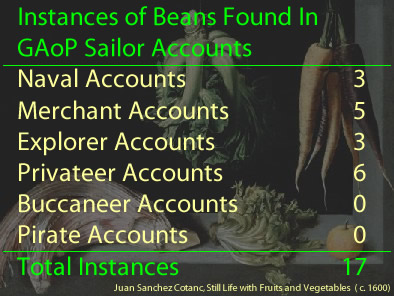
Beans
(Phaseolus vulgaris & Lablab purpureus)
Called by Sailors: Bean, Calavance, Callavance
Vegetable Type: Legume
Appearance: 15 Times, in 10 Unique Ship Journeys from 9 Sailor Accounts.1
Locations Found in Sailor's Accounts: Italy; Alexandria, Egypt; Isle of Mayo, Cape Verde Islands; St. Helena; Mauritius; Surat, India; Salvador & St. Catherine's Island, Brazil; Chiloé Island & Iquique, Chile; Puerto San Julián, Argentina; Paita, Peru; Diafara, Panama;
Beans are one of the more popular vegetables found in the sailor's account. This should not be surprising given that some type of bean grows in every continent save Antarctica and the
navy sometimes substituted dried beans for the traditional sea-going naval vegetable peas. Several accounts simply mention 'beans'2 without giving any indication to which type of the hundreds of varieties of beans grown
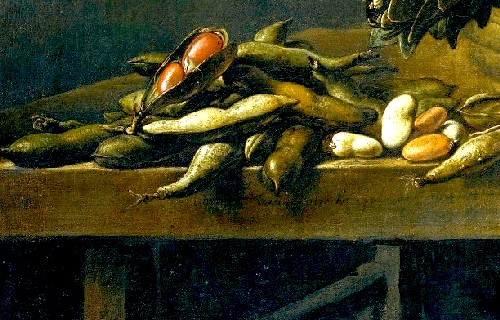
Artist: Adriaen van Utrecht
A Variety of Common Green Beans, From Still Life of Vegetables On a Wooden Bench (1641)
around the world they mean. Other sailor's accounts provide a little more detail, although trying to identify which the type of bean can still be challenging. This is because a variety of vegetables are referred to by the general term 'bean' including common green beans (often called French beans at this time), fava beans, hyacinth beans (often called calavances) and garbanzo beans. For our purposes, beans are restricted to common green beans and hyacinth beans, with individual entries in this article being devoted to fava and garbanzo beans. Given that common green beans (Phaseolus vulgaris) and hyacinth beans (Lablab purpureus) are today considered distinctly different genera, they should really be given their own sections as well. However, during the period of interest, they are difficult, even impossible, to disentangle in the sailor's accounts.
The term 'French bean' is found in only 1 account.5 Captain Alexander Hamilton said he found them in Surat, India, but what he is referring to is not at all clear. 'French beans' today refers specifically to a cultivar of the common green bean called haricot vert (literally "green bean" in French), which is one of many types of common green bean.6 However, it is unlikely that this is what he meant because most cultivars of common green beans were simply referred to as French beans at this time, likely because they became popular in France after their introduction there in the late 16th century.
The common green bean likely originated in South and Central America,
most likely being brought to Europe by Columbus from his second voyage.7 By the golden age
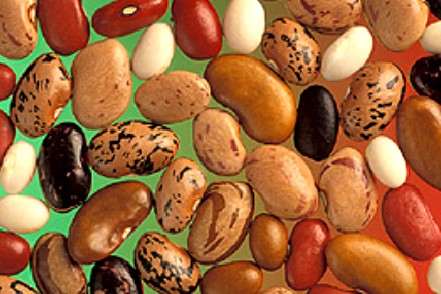
Photo: USDA - A Variety of Dried Common Bean Seeds (Phaseolus vulgaris)
of piracy, their seeds had been planted in many places in the Old World. Edward Phillips' dictionary equates French beans with kidney beans8, which are indeed one cultivar of the common green bean. The Dictionary Rusticum likewise says kidney beans are equivalent to French beans, although it says there are four types - the scarlet [kidney] bean, the streaked or painted [possibly pinto] bean and the large and small white [navy] beans.9 Herbalist John Gerard identifies ten different types of Kidney Beans including white, black, red, pale yellow (probably peruano), Indian small white, Indian small red, narrow leafed, Brazil, party colored Egyptian and American purging beans.10 These are almost certainly different-colored cultivars of the common green bean. Of particular note from Gerard's identification are the Indian white and red beans, which could have been what Hamilton was referring to. William Funnel talks about the privateer St. George taking an 'Indian town' by Panama in 1704 where "we found store of …white and black Beans", which almost certainly refer to the seeds of common green beans.11
Another type of bean substituted for peas as food at sea by the English navy were 'calavances'. They appear 7 times in four different sailor's accounts.12
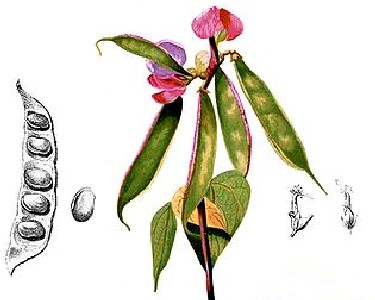
Hyacinth Beans (Lablab Purpureus), From Flora de Filipinas,
By Francisco Manuel Blanco (1880-3)
The word itself is a corruption of the Old Spanish word 'garbanço', which refers to the garbanzo bean or chickpea. However, typical of the imprecise word use during this period, 'calavance' can actually refer to "[a]ny bean, but especially the hyacinth bean (Lablab purpureus)"13. As a result, it cannot automatically be presumed to refer to chickpeas when found in the sailor's accounts.
Buccaneer William Dampier describes those he found on the Isle of Mayo in the Cape Verde Islands in 1699 as "a sort of Pulse like French Beans"14. The Cape Verde Islands grow both common green and hyacinth beans15 making it uncertain which type Dampier was talking about. The Dictionaire Oeconomique identifies the bonavista (bonavist) bean "a kind of French Bean, which will grow with us [the English], especially if the Summer be kindly."16 However, 'bonavist beans' are just another name for hyacinth beans, not French (or common green) beans, so it is possible Dampier had them confused.
Period sailors don't discuss how common green beans would be prepared, although they would almost certainly
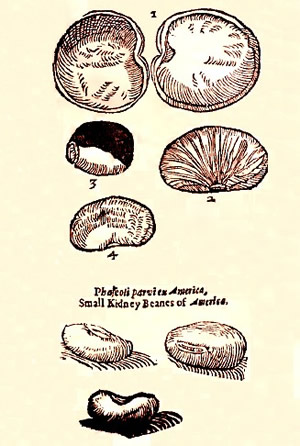
The French of Kidney Bean Seed, From Theatrum Botanicam,
By John Parkinson (1640)
Legend:
"1 -
Paseoli Americani Purgances. 2. Lati magni albi
3.
Ægyptiii 4. Brasiliani. Foure sorts of Outlandish Beans."
have soaked dried bean seeds given their long-lasting nature and then boiled them in the large pots found on most ships during this period. As French botanist Louis Lémery points out, "They dry Beans in order to keep them the longer"17, appropriate for long distance ship travel. When on land they could have eaten prepared fresh beans, something period botanists discuss. However, Gerard warns against drying them, noting that once they have fully ripened "they are neither toothsome nor wholesome. Therefore they
are to be taken whilest they are yet greene and tender, which are first boyled untill they be tender;
then is the rib or sinew that doth run alongst the cod to be taken away; then must they be put into a stone pipkin,or some other vessell with butter, and set to the fire againe to stew, or boyle gently:
which meat [food] is very wholesome,nourishing, and of a pleasant taste."18
John Parkinson agrees with Gerard, explaining that common green bean seeds can be shelled and then "boyled in faire [clean, pure] water and a little salt, and afterwards stewed with some butter, a little vinegar and pepper being put unto them, and so eaten: or else eaten alone after they are boyled without any other sawce." He adds that they can also be "boyled in water huske and all, onely the ends cut off, and the firing taken away, and stewed with butter &c. are esteemed more savory meate to many mens pallates"19. Parkinson draws class distinctions around the way beans were eaten, indicating that the wealthy ate them whole as green beans, while the poor ate the shelled bean seeds. Sailors were of the lower class, so dried bean seeds would have been familiar to them. Although Gerard did not suggest this, it may explain why he called them unwholesome once ripe.
As with green beans, sailors do not give details on how hyacinth beans tasted or were prepared, so for them we must rely on information from the period physicians. Hans Sloan found hyacinth beans on Jamaica and Barbados which he noted had a variety of names including Phaseolus Lablab and Red and White 'Bona
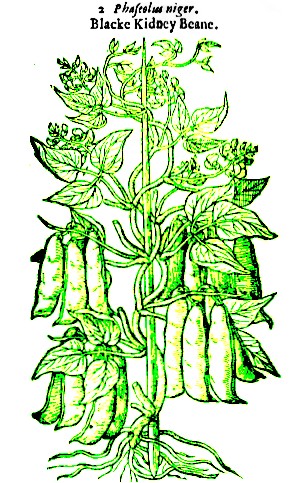
Black Kidney Bean Plant (Common Green Bean)
From
The Herball or General Historie of Plantes,
By John Gerard
(1636)
Vist. Beans'. He said they were sometimes planted in gardens, "though [the red are] not so generally lik'd as the white Kind [of bonavist seeds], because of their greater flatulency. The Ægyptians use them for Food, and they are not less pleasant than our Beans to the tast."20 Buccaneer physician William Hughes also noted the presence of hyacinth beans, calling them Calavancs or Calavances. "They are very good food, much easier of digestion than ours are [referring to English vetches]". He says they are prepared "when they are green, they boil and butter them, and so they do sometime when they are dry; or else they boil and eat them with Pork, or Wild Hog"21. Georg Eberhard Rumphius, a German botanist working for the Dutch East India Company, explained, "They are a common food throughout the [East] Indies, though they do not taste as good as our European beans [probably referring to common green beans], and require fat sop [something edible soaked in liquid, such as bread], the green pods are cut very fine, for one rarely eats the ripe ones."22
Humorally, Gerard cites the 'Arabian Physitians' as indicating common green beans are hot and moist. Parkinson says the same, noting that they have these properties in the first degree.23 Gerard elsewhere explains that they "ingender good bloud [one of the bodily humors] reasonable well".24 From a Paracelsian perspective, Louis Lémery states, "They contain much Oil, and essential Salt. They agree at all times, with young bilious Persons, and those who have a good Stomach." He adds that they "allay the sharpness of humors."25 None of the botanical or physician authors under study indicate the humoral properties of hyacinth beans, although they would likely thought similar to those of the common green bean.
Gerard lists the medical properties associated with common green

Artist: Alessandro Bonvicino - Pietro Andros Mattioli (c. 1533)
beans which were not yet fully ripe. He advised that they "gently loose the belly, provoke urine" and resulted in the production of good blood as mentioned previously.26 Parkinson agrees, adding that common green beans "enlarge the breast that is streightened with shortnesse of breath, engender sperme, incite venery [lust], especially if Sugar, Pepper, Genger and Galanga be added thereto". He also cites physician Pietro Andrea Mattioli's assertion that "if the greene pods be chewed in ones mouth, and applied to any place that is bitten by an horse it will helpe"27. Lémery adds that they "cause Sleep ...provoke Urine, remove the Megrim [migraine], and are very nourishing; they are detersive [cleansing]
and binding, when taken in Decoctions". He says they can be made into a flour "which is used in Cataplasrns, for dissolving, softning, digesting and forwarding Suppuration [formation of pus - believed to the ejection of bad humors from the body]."28
The medicinal properties of hyacinth beans don't get quite as much attention in the texts. Hans Sloane cites the work of Venetian physician and botanist Prospero Alipini as indicating that hyacinths are "helpful for the Cough, difficulty of breathing, and to provoke suppress'd Urin."29 Buccaneer physician Hughes only says they are "somewhat flatulent, and provoke bodily lust"30. Not surprisingly, all of these medicinal properties are suggested by the botanists for common green beans.
1 Edward Barlow, Barlow's Journal of his Life at Sea in King's Ships, East and West Indiamen & Other Merchantman From 1659 to 1703, p. 199 & 402; William Dampier, A New Voyage Round the World, Vol III, 1703, p. 23, 72 & 151; Peter Earle, Sailors: English Merchant Seamen 1650-1775, 1998, p. 88; William Funnell, A Voyage Round the World, 1969, p. 150; Alexander Hamilton, A New Account of the East Indies, 1746, p. 68 & 144; Stephen Martin-Leake, The Life of Sir John Leake, 1920, p. 222; George Shelvocke, A Voyage Round the World by Way of the Great South Sea, 1726, p. 52, 94, 189, 268 & 300; Nathaniel Uring, The Voyages and Travels of Captain Nathaniel Uring, 1928, p. 106-7; John Wood, "Captain Wood's Voyage Through the Streights of Magellan, &c.," William Hacke, ed., A collection of original voyages, p. 73; 2 Barlow, p. 199 & 402; Earle, p. 88; Shelvocke, p. 94 & 189; Wood, p. 73; 3 Baltharpe, p. 54; 4 "Vicia faba", wikipedia.com, gathered 10/4/22; 5 Dampier, p. 23 & Hamilton, p. 144; 6 Lauren Allen, "French Green Beans (Haricots Verts)", Tastesbetterfromscratch.com, gathered 10/5/22; 7 "Phaseaus vulgaris", missouribotanicalgarden.org, gathered 10/5/22; 8 Edward Phillips, "Arico", The new world of words, 6th ed, 1706, not paginated; 9 John Worlidge & Nathan Bailey, Dictionarium Rusticum, Urbanicum & Botanicum, 1704, not paginated; 10 John Gerard, The Herball or General Historie of Plantes, 2nd ed, 1636, p. 1211-5; 11 Funnell, p. 150; 12 Dampier, p. 23 & 72; Martin-Leake, p. 222; Shelvocke, p. 52, 189 & 168; Uring, p. 107; 13 "Calavance etymology", etymologeek.com, gathered 10/5/22; 14 Dampier, p. 23; 15 Daniel Marino, "How Cabo Verde indigenous beans could boost food security", theconversation.com, gathered 10/5/22; 16 Noel Chomel, "BONAVISTA", Dictionaire Oeconomique, 1725, not paginated; 17 Louis Lémery, A treatise of foods in general, 1704, p. 58; 18 Gerard, p. 1216; 19 John Parkinson, Paradisi in Sole, Paradisus Terrestris, Reprinted from the Edition of 1629, 1904, p. 521; 20 Hans Sloane, A Voyage to the Islands Madera, Barbados, Nieves, St Christophers and Jamaica, Vol. 1, 1707, p. 177; 21 William Hughes, The American physitian, 1672, p. 18; 22 Georgius Everhardus Rumphius, The Ambonese Herbal, E. M. Beekman, Ed, Vol. 4, 2011, p. 392; 23 John Parkinson, Theatrum Botanicum the Theater of Plants, 1640, p. 1058; 24 Gerard, p. 1216; 25 Lémery, p. 58; 26 Gerard, p. 1216; 27 Parkinson, Theatrum Botanicum, p. 1058; 28 Lémery, p. 58; 29 Sloane, p. 177; 30 Hughes, p. 18
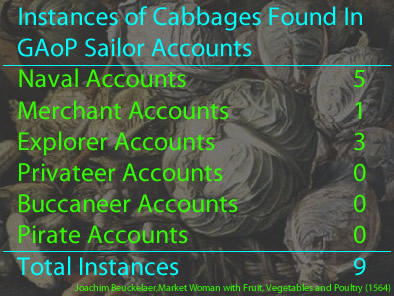
Cabbage
(Brassica oleracea)
Called by Sailors: Cabbage
Vegetable Type: Salading
Appearance: 9 Times, in 7 Unique Ship Journeys from 7 Sailor Accounts.1
Locations Found in Sailor's Accounts: Thames, England; Madeira, Portugal; Messina & Sardinia, Italy; Tenerife, Canary Islands; Cape Coast Castle, Africa; Kupang, Timor, Indonesia; Salvador, Brazil;
Cabbage was common food amongst the lower classes in England, so it should not be surprising that sailors mentioned it several times. It was one of the foods fed to English sailors while they were waiting to leave port after Samuel Pepys attempted to reform the pursery in the later half of the seventeenth century. Rear Admiral John Narborough, who was waiting at the Nore, a sandbank at the mouth of the Thames in 1672, listed some of the fresh food sent to him for the sailors. "This day ...came down ...a vessel laden with 3950 cabbages and 211 bushels of carrots and 15 dozen and 9 bunches of turnips, for to be disposed of for the use of the fleet in the several ships for
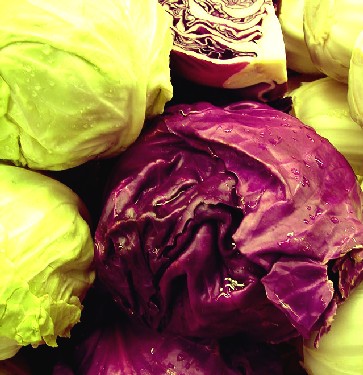
Photo: Forest and Kim Starr
Green & Red Cabbages (Brassica oleracea var. capitata)
refreshing of the men. ... I made a dividend of my carrots and cabbages and turnips to the whole fleet, a cabbage for four men and a bushel of carrots for ten men."2
Beyond this, they had little to say about it in their accounts. In fact, it is primarily mentioned as being found in European countries. It is also interesting that all the instances where it is mentioned come from the 'legitimate' accounts. This could be because the privateers, buccaneers and pirates disdained the leafy vegetable, but is it more likely because their accounts focus primarily on the West Indies and, to a lesser extent, the East Indies where it wasn't quite as common.
Fortunately, as with most European cuisine, the period herbalists have much to say about cabbage. Botanists John Parkinson lumps them in with coleworts although he also indicates that they are a separate vegetable.2 Physician Hans Sloane goes so far as to give them completely different scientific names: he identifies coleworts as Brassica vulgaris sativa and cabbage as Brassica capitata alba.3 Yet coleworts and cabbages are today just identified as different cultivars of Brassica oleracea. Since they are treated separately in the sailor's accounts and texts and some of the herbals and physicians books, they have separate entries here.
Parkinson begins by noting, "There is greater diversity
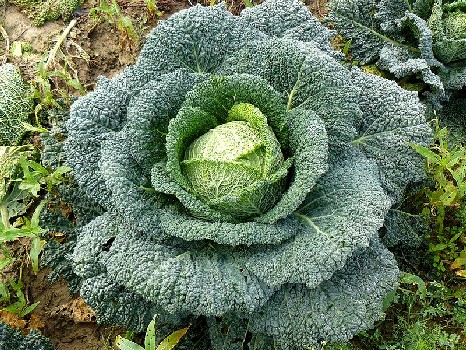
Photo: Felix Potuit - Savoy Cabbage (Chou de Milan)
in the forme and colour of the leaves of this plant, then there is in any other that I know groweth upon the ground."4 However, he quickly backs away from that and says he will only discuss those types found in 'most Gardens' in England. Among these are the 'common white' (green/purple) cabbage, the 'red' (or purple) cabbage, the 'sugar loaf Cabbage', "so called because it is smaller at the toppe then it is at the bottome, and is of two sorts, the one white, the other greene", and the 'Savoy Cabbadge', "one [type of which] is of a deepe greene coloured leafe, and curld when it is to be gathered; the other is yellowish: neyther of both these doe close so well as the first, but yet are used of some, and accounted good"5.
Parkinson describes 'ordinary' cabbages with leaves that "closeth hard and round, hath at the first great large thicke leaves, of a grayish greene colour, with thicke great ribbes... toward the end of Summer, being growne to have many leaves, it then beginneth to growe close and round in the middle, and as it closeth, the leaves growe white inward"6. Botanist John Gerard said the common cabbage ripened in the winter. "The root is hard,and the stalks of a wooddy substance."7
As food, botanist Louis Lémery says cabbages "ought to be chosen that are tender, large, and full. Cabbages are an indifferent Nourishment."8 Gerard reports, "the great ordinary Cabbage [is] knowne every where, and is commonly eaten all over this kingdome."9 Parkinson doesn't say much about the flavor of cabbages, although he states, "They are most usually boyled in poudered beefe broth until they be tender, and then eaten with much fat put among them." He adds an interesting comment that doesn't really relate to sailors, but is worth repeating for the social commentary. "In the cold Countries of
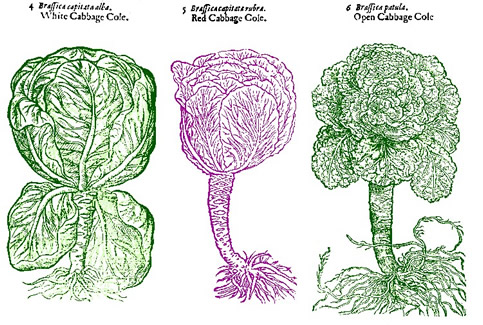
Cabbages From The Herball or General Historie of Plantes, By John Gerard (1636)
Russia and Muscovia, they pouder up a number of Cabbages, which serve them, especially the poorer sort, for their most ordinary foode in winter; and although they stinke most grievously, yet to them they are accounted good meate [food]."10
Humorally, Gerard says cabbages are drying. However, he also warns that cabbages "doth not ingender good, but a grosse and melancholicke bloud."11 Lémery is more expansive. Using the Paracelsian principles, he says they "contain an indifferent quantity of Oil, and much essential Salt and Phlegm." He notes that they have 'ill effects'. "Cabbage produce gross Humours; cause Vapours, and are hard of Digestion, and therefore they usually boil them well before they are eaten; and they also put a little pepper upon them, in order to help the digesting of them in the Stomach."12
Gerard reports the medicinally, cabbages are binding and they
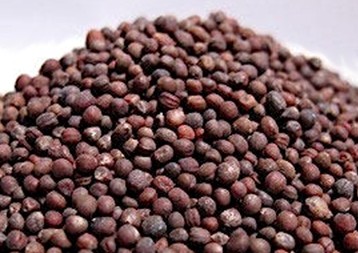
Red Cabbage Seeds
"mightily clense, either in juice or in broth". He explains that this comes from the watery substance in a cabbage which is released by boiling. The water in which it was boiled "looseth the belly" while the remaining boiled cabbage "doth... dry and bind the belly."13 He also cites a number of health properties suggested by other herbalists and physicians, although he doesn't seem to endorse them. Parkinson talks at some length about how they dry up the milk in nursing mothers but, again, doesn't seem to endorse this opinion. Cabbage seeds "grossely bruised and boyled a little in flesh broth, is a present remedie for the Collicke; the seede and the broth being taken together, easing them that are troubled therewith of all griping paines: as also for the stone in the kidneyes."14 Lémery affirms that the water cabbage is boiled in is 'laxative', explaining that this is due to "the Salts pricking the Intestinal Glands a little, caus[ing] a light Evacuation". He says this leaves "nothing but the more earthy Substance of the Cabbage, which is proper for thickning the Liquors [fluids], and giving them a greater Consistence."15
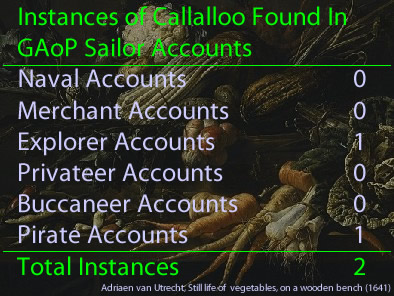
Callaloo (Amaranth)
(Amaranthaceae amaranthus)
Called by Sailors: Callalloo, Kulula
Vegetable Type: Salading
Appearance: 2 Times, in 2 Unique Ship Journeys from 2 Sailor Accounts.1
Locations Found in Sailor's Accounts: São Tomé, Príncipe, and Annobón; Timor, Indonesia;
While Callaloo or Amaranth is only found in two sailors accounts, it is interesting because one of them is from William Dampier's exploratory voyage to Australia when he visited Timor and the other comes from a description of the island of Principe included in the General History of the Pyrates which was written by sea surgeon John Atkins. Both give brief descriptions of what it is, something unusual for vegetables.
There are currently seventy-five identified Amaranth species and they are found in every continent except Antarctica, although they are believed to have originally come to the Old World from the New World before Columbus.2 Both the leaf and the seed of the Amaranth plant are edible. However, the sailors accounts only talk about using the leaf, which is why it is classified here as salading. Surgeon Atkins simply describes it as "a herb like Spinnach"3. Dampier says, "It grows wild here [in Timor, although he refers back to finding it in the West Indies]. I eat of it several times, and found it as pleasant and wholesome as Spinage."4

2. Small Wild Red Blite (Amaranth), From Theatrum Botanicum, By John Parkinson (1640)
Botanist John Parkinson identifies six types of amaranths which he calls blites. (This reason for this will be explained shortly.) The plants he identifies include the small wilde white blite, the small wilde red blite, wilde blites with much seede, greater Virginia blite, smaller Virginia blite and the greatest scarlet Flower gentle.5 He notes that these are all garden plants, providing descriptions of them without an indication of whether they are edible or not.
Physician Hans Sloane mentions nine amaranth plants he found on Jamaica and throughout the Caribbean, three of which he identifies by the scientific name Amarnthoides, three as Amarantus and three as Blitium.5 (Those last three are why Parkinson calls them Blites.) Amaranthoides and Blitiums are today classified as being in the family Amaranthaceae, with Amaranthoides being genii axyrus, species amaranthoides and Blitiums being subfamily Chenopodioideae, genus blitium. Plants from the Blitium genus are closely related to genus Spinaca which contains spinach.6 In line with this, all of Sloane's entries for Amaranthoides and Amarantus simply talk about the characteristics of the plant without mentioning their use as food or medicine. Of the three Blitium plants, only his entry for Blitum minus album polyspermon folio subrotundo mentions using the plant for food and medicine. This is most likely Amaranthus viridis, also called slender amaranth or green amaranth.
 Types of Blites (Amaranths), From Theatrum Botanicum the Theater of Plants, By John Parkinson (1640) 1. Small wilde white blite, 3. Wilde blites with much seede, 4. Scarlet Flower gentle, 5. Variable Flower-gentle, 6. Greater Scarlet tufted |
Regarding the flavor and preparation of this blitium, Sloane says,
It grows every where in the low Lands, and Plantations [of Jamaica], and is to be gathered very plentifully every where after Rain. It is gathered, and when the Leaves are stript off, and boiled as a Sallet [like spinach], is one of the pleasantest I ever tasted, having something of a more fragrant and grateful tast, than any of these Herbs I ever knew: whence likewise 'tis shred and boiled in Pottages [soups or stews] of all sort8
John Parkinson has an unfavorable opinion of amaranths. In one of his books, Parkinson, citing Galen, explains that an amaranth "is a pot-herbe serving for meat... It yeelds to the body small nourishment... for it is one of the pot-herbes that be unsavorie or without taste, whose
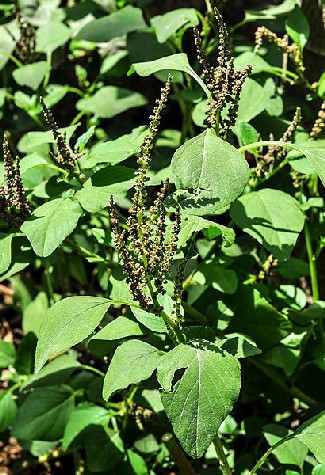
Photo: Flickr User Joydeep - Amaranthus viridis
substance is waterish."9 In his other books, he advises, "Blites are used as Arrach [orach - another amaranth, Atriplix hortensis] eyther boyled of it selfe or stewed, which they call Loblolly, or among other herbes to bee put into the pot... It is altogether insipide or without taste... The unsavorinesse whereof hath in many Countries growne into a proverbe, or by-word, to call dull, slow, or lazie persons by that name."10 In fairness, he was talking about the type of amaranths that grew in Europe, while Sloane was talking about those in Jamaica, which could explain the differences in opinion on the flavor. From a modern viewpoint, amaranth (callaloo) "leaves have a slightly bitter flavor with a nutty undertone that is very similar to spinach, and the grains can be toasted or boiled."11
From a humoral perspective, Parkinson reports amaranths are cooling and drying.12 Herbalist John Gerard, on the other hand, says they are "of a cold moist temperature, and that chiefely in the second degree."13 This is unusual; Gerard borrowed from Parkinson's first book and Parkinson borrowed from Gerard in his second book.
Medicinally, Sloane said the amaranth "is emollient [softening], loosning, and provokes to a Stool. It is used in Clysters [enemas] in the Belly-ach, as the best and most common emollient Herb, this Country affords."14 Gerard agrees that it loosens the stomach, adding, "I have heard many old wives say to their servants, Gather no Blites to put into my pottage, for they are no good for the eie-sight. Whence they had those words I know not, it may be of some Doctor that never went to schoole; for that I can find no such thing upon record, either among the old or later writers."15 However, Parkinson reports, "They are accounted more hurtfull to the stomacke, and so to the head and eyes, then other herbes, and therefore they are the lesse used."16 He also says that, according to Galen, amaranths are binding and "serve to restraine the fluxes of blood in man or woman."17 Curiously, these properties disagree with much of what Sloane and Gerard wrote.
1 William Dampier, A Continuation of a New Voyage Round the World, Vol III, 1709, p. 73; John Atkins in Daniel Defoe (Capt. Charles Johnson), A General History of the Pyrates, Manuel Schonhorn, ed., 1999, p. 183; 2 Amaranth, wikipedia.com, gathered 10/21/22; 3 Atkins, A General History..., p. 183; 4 Dampier, p. 73; 5 John Parkinson, Theatrum Botanicum the Theater of Plants, 1640, p. 753-4; 6 Hans Sloane, A Voyage to the Islands Madera, Barbados, Nieves, St Christophers and Jamaica, Vol. 1, 1707, pp. 141-4; 7 Blitium, wikipedia.com, gathered 10/21/22; 8 Sloane, p. 143; 9 John Parkinson, Paradisi in Sole, Paradisus Terrestris, Reprinted from the Edition of 1629, 1904, p. 489; Maya Marie, Ayllen Kocher, and Amara Ullauri,"Callaloo (Amaranth Greens)", rocksteadyfarm.com, gathered 10/21/22; 12 Parkinson, Theatrum Botanicum..., p. 755; 13 John Gerard, The Herball or General Historie of Plantes, 2nd ed, 1636, p. 321; 14 Sloane, p. 143-4; 15 Gerard, p. 321; 16 Parkinson, Paradisi in Sole..., p. 489; 17 Parkinson, Theatrum Botanicum..., p. 755
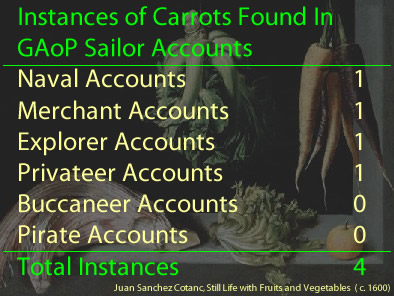
Carrot
(Daucus carota subsp. sativus)
Called by Sailors: Carrot
Vegetable Type: Root
Appearance: 4 Times, in 4 Unique Ship Journeys from 4 Sailor Accounts.1
Locations Found in Sailor's Accounts: Thames, England; Messina, Italy; Jakarta, Indonesia; Puerto San Julián, Argentina;
Carrots appear in a couple sailor's accounts, always as food procured when a ship touched land. Fresh foods became a more significant part of the English navy diet when their ships were in port after Samuel Pepys attempted to reform the pursery in the later half of the seventeenth century. While sitting at a sandbank at the mouth of the Thames called the Nore in 1672, Rear-Admiral John Narbrough reported that that he was sent "a vessel laden with ...211 bushels of carrots... for to be disposed of for the use of the fleet in the several ships for refreshing of the men ... I made a dividend of my carrots... a bushel of carrots for ten men."2 This procedure would have trickled down to other types of legitimate ships over time, and, while their mention is infrequent, they are well dispersed among the legitimate vessels.
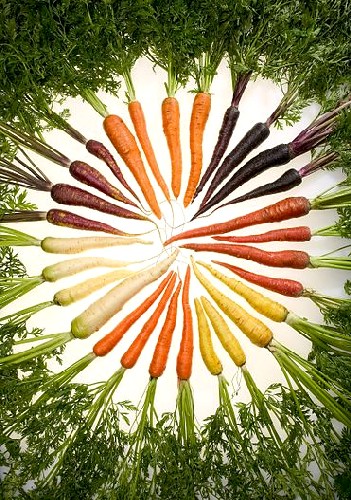
Wild carrots probably first appeared in Persia and were cultivated through breeding over the millennia. The now familiar orange carrot was likely created by Dutch farmers in the seventeenth century "through selective breeding as a sweeter and less bitter variety than its yellow counterparts. It was then adopted as a royal vegetable in honor of the House of Orange."3 Carrots were brought to the New World by European settlers in the same century.
The carrots described by the English authors in both the Old and New Worlds do not describe them as orange. Physician Hans Sloane noted that in Jamaica he found yellow, white and red carrots.4 Merchant and vegetarian Thomas Tryon says "the best sort of them are those which are of the deepest Red Colour, when they are eat[en] in their proper season". He adds, "The Colour of Carrots do declare that there is excellent Vertue in them."5
Writing in 1636, herbalist John Gerard reported that the best garden carrots were "long, thicke and single, of a faire yellow colour". He added that there was also another type of carrot "of a blackish red colour."6 French botanist Louis Lémery suggests the best carrots "are long, thick, yellow, or of a pale white Colour, tender, easy to be broke."7 Author, gardener and Commissioner of the Navy's Sick and Hurt Commissions (second and third) John Evelyn similarly reported that "the best [carrots] are yellow, very nourishing; [if you] let them be rais'd in Ground naturally rich, but not too heavy."8
As food, Lémery suggests that the best carrots have "a taste inclining to Sweet", noting that they "are Roots much used in Kitchins, because of their Taste, which is agreeable enough"9. Tryon says "they are a pleasant wholsom Root, which is from the Month of July to the Month of December, or thereabouts; after that time they are not so wholsom... This Root being eaten presently after it is pulled up
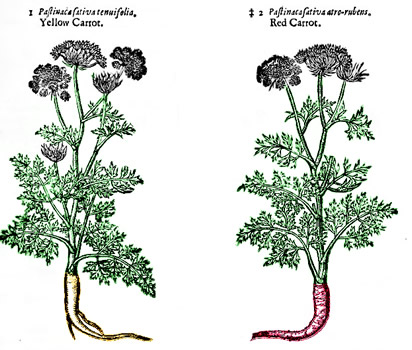
Yellow and Red Carrots, From The Herball or General Historie of Plantes,
By John Gerard (1636)
out of the Ground, and when it is well order’d, is not much inferior to Turnips"10. He says they can either be eaten with meat or without. Gerard doesn't say anything about the flavor, but notes, "The root of the yellow Carrot is most commonly boyled with fat flesh and eaten"11.
According to Gerard, a carrot's humor "is temperately hot and something moist"12. He adds that carrot seeds are hot and dry. Evelyn suggests the whole carrot is humorally warm and dry.13 Speaking of Paracelsus' principles, Lémery says carrots "contain much Oil, and essential Salt."14
Medicinally, Gerard has little to say of the carrot itself, other than it wasn't nutritionally of much value and it caused wind. Conversely, he says that carrot seeds "breaketh and consumeth windinesse, [and] provoketh urine"15. So carrots should apparently be eaten with their seeds. Evelyn disagrees with Gerard's assessment of their value as food, calling them "very nourishing."16 Lémery says that these vegetables "are opening, expel the Stone, purify the Blood, and help Women's Terms. ... They agree at all times, with any Age and Constitution."17 Tryon states that turnips are "of an opening and cleansing Nature, easie of Concoction, and may with safety be eaten plentifully, either without or with Flesh."18
1 Edward Barlow, Barlow's Journal of his Life at Sea in King's Ships, East and West Indiamen & Other Merchantman From 1659 to 1703, p. 239; Edward Cooke, A Voyage to the South Sea and Round the World, Vol. 2, 1712, p. 60; N. A. M. Rodger, The Command of the Ocean, A Naval History of Britain, 2006, p. 133; John Wood, "Captain Wood's Voyage Through the Streights of Magellan, &c.," A collection of original voyages, William Hacke, ed., p. 73; 2 Rodger, p. 133; 3 Hans Sloane, A Voyage to the Islands Madera, Barbados, Nieves, St Christophers and Jamaica, Vol. 1, 1707, p. LXXIV; 4 Heather Teoh, "The Multi-Colored History of Carrots", FoodLiteracyCenter.org, gathered 10/25/22; 5 Thomas Tryon, The way to health and long life, 1697, p. 146; 6 John Gerard, The Herball or General Historie of Plantes, 2nd ed, 1636, p. 1027; 7 Louis Lémery, A treatise of foods in general, 1704, p. 109; 8 John Evelyn, Acetaria, or a Discourse of Sallets, 1699, p. 17; 9 Lémery, p. 109; 10 Tryon, p. 146; 11,12 Gerard, p. 1028; 13 Evelyn, p. 17; 14 Lémery, p. 109; 15 Gerard, p. 1028; 16 Evelyn, p. 17; 17 Lémery, p. 109; 18 Tryon, p. 146
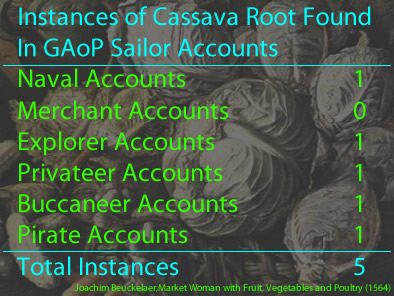
Cassava Root
(Manihot esculenta)
Called by Sailors: Casava, Cassander, Cassava, Manyoco
Vegetable Type: Root
Appearance: 5 Times, in 5 Unique Ship Journeys from 5 Sailor's Accounts.1
Locations Found in Sailor's Accounts: São Tomé, Príncipe, and Annobón; Barbados, Salvador & Santa Caterina Island, Brazil; Panama;
Cassava or manioc is a plant which likely originated in Brazil, being cultivated widely throughout South and Central America by 1000 BC.2 Its use as food comes from the starch found in the root, used to make a flour called tapioca. It is almost pure carbohydrates, often being used used to bake a substitute for bread by indigenous people. The process for extracting tapioca and making it into pieces of flat bread reminiscent of tortilla wraps was described and illustrated around the golden age of piracy by several travelers. A fairly thorough account of the process was given by Richard Ligon, a resident of Barbados between 1647 and 1650, which is found in this article.
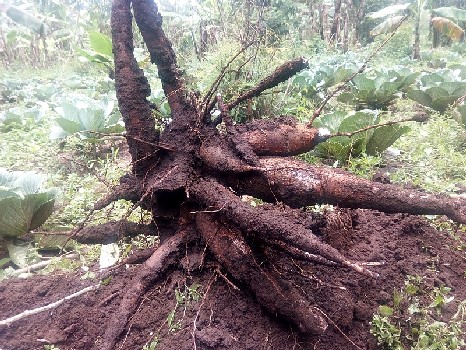
Harvesting African Cassava Roots
While the total number of sailor mentions of cassava is on the low end, it is found in nearly every type of sailor account. Being somewhat unusual to English sailors, two of them provide descriptions of it. William Dampier is surprisingly not one of them, although he mentions it while in Brazil in 1699. Privateer George Shelvocke explained that when he stopped at Santa Caterina Island, Brazil, he purchased "150 bushels of Farina de Pao, which is the flower of Cassader [cassava] root, as fine as our oatmeal"3. Sea surgeon John Atkins provides a description in the section he wrote for the General History of the Pyrates about the islands São Tomé, Príncipe, and Annobón in the discussion of Howell Davis. He explains, "the Islanders make a Farine or Flower, which they sell at three Ryals a Roove, and drive a considerable Trade for it with the Ships that call in." He adds that it "is a hearty Food for the Slaves"4, likely the reason they sold so much of it. Slave ships sometimes stopped at these islands before crossing the Atlantic.
Several authors describe the cassava plant, although since the root is the only part eaten, they aren't repeated here.
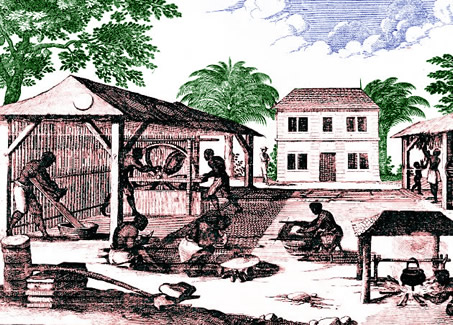
Artist: Jean Baptiste Du Tetre
Processing Cassava Root to Make Flour - The Pressing Wheel is at the Back of the Left
Structure,
From Histoire generale
des Antilles (1667)
Buccaneer physician William Hughes says "the roots... become very big and white, of several shapes; for the use of it which is much planted"5. Naval physician Hans Sloane said the cassava on Jamaica was processed from "an oblong tuberous Root, as big as ones Fist, having some fibers drawing its Nourishment, and being full of a wheyish venemous Juice."6
The 'venemous juice' found in cassava roots is a type of cyanide. In discussing the way the root was processed, physician Atkins says they must first "press the Juice from it, (which is poisonous) [is] done here [São Tomé] with Engines"7. Hughes describes the 'engines' he saw as "a wooden wheel made to turn, as our Grinding-stones are: this wheel is athwart the circumference, about a foot broad, upon which is made fast a piece of Tyn or Iron, full of holes, as our Graters are; upon which one holding the Root, and another turning the Wheel, they grate it small, there being a trough put under the wheel wherein it falleth"8. (This can be seen near the center of the above image.) The grated roots are then pressed to expel the liquid, leaving 'Cakes' which are about a half inch thick.
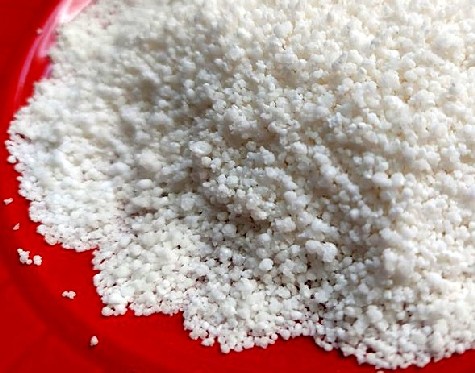
Photo: Linason Blessing - Uncooked Tapioca
From the flour, Atkins says that those living in São Tomé, Principe, and Annobón can "boil, as we do our Wheat [which could be done to make a savory pudding of porridge], ... or make it into a Bread, fine, white, and well tasted, for themselves."9 Privateer Shelvocke reported that cassava flour "is very hearty eating, and prepar'd without any farther trouble than boiling the water, and soaking a quantity of this Farina in it, which makes a kind of burgou [oatmeal] immediately."10 Hughes said the flour "will dissolve in cold water, but in anything that is hot it dissolveth not so soon; but rather mollifies [softens], and remains in a lump. Some use it to thicken Chocolate: It is not very clammy; and therefore nourisheth not very much, neither hath it a grateful taste alone."11
Sloane is the only author to talk about a medicinal use, explaining that the "Tipioca, if well kept, is good against Dysenteries, &c."12 He devotes a large part of his text to treating those poisoned by improperly prepared root, basically recommending the usual remedies used in such cases: emetics, diuretics and enemas.
1 John Atkins, A Voyage to Guinea, Brazil and the West Indies, 1735, p. 217; William Dampier, A New Voyage Round the World, Vol III, 1703, p. 72; John Atkins in Daniel Defoe (Capt. Charles Johnson), A General History of the Pyrates, Manuel Schonhorn, ed., 1999, p. 183; Ravaneau de Lussan, The History of the Buccaneers of America, 1856, p. 329; George Shelvocke, A Voyage Round the World by Way of the Great South Sea, 1726, p. 52; 2 Kenneth M. Olsen and Barbara A, Schaal, "Evidence on the origin of cassava: Phylogeography of Manihot esculenta", Proceedings of the National Academy of Sciences of the United States of America, Vol. 96, gathered from the internet 10/26/22; 3 Atkins in Defoe (Charles Johnson), p. 188; 4 Shelvocke, p. 52; 5 William Hughes, The American physitian, 1672, p. 90; 6 Hans Sloane, A Voyage to the Islands Madera, Barbados, Nieves, St Christophers and Jamaica, Vol. 1, 1707, p. 130; 7 Atkins in Defoe (Charles Johnson), p. 188; 8 Hughes, p. 91; 9 Atkins in Defoe (Charles Johnson), p. 188; 10 Shelvocke, p. 52; 11 Hughes, p. 91; 12 Sloane, p. 131

